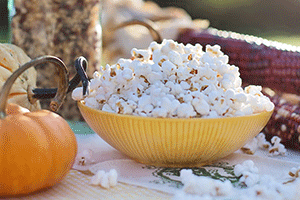The history of popcorn in the Americas is very old, with the oldest samples of popcorn found in the Bat Cave of west central New Mexico dated at about 4,000 years old. According to the Popcorn Board, an organization of U.S. popcorn processors, it’s thought that the first use of wild and early-cultivated corn in the Americas was for popping. Popcorn was important to Aztec Indian ceremonies and an important food for them, too.
Of course the unique feature of popcorn, is it’s exploding seed. Moisture in the kernel is converted to steam when heated, causing the seed to explode and turn itself inside out. Popcorn is considered a whole grain, full of complex carbohydrates and fiber, and if you don’t add too much butter, is a very healthy snack food. A lightly buttered cup of popcorn only contains 80 calories!
Many varieties of popcorn are available for the home garden, including some with fun kernel colors like red and dark blue, along with the more common white and yellow. Ear size is also quite variable, from 2 to 3 inches long for ‘Strawberry’ popcorn to 7.5 inches for ‘Robust 128-YH’ hybrid popcorn. Popcorn seed is available from many garden centers, or through mail order companies such as Park Seed, Burpee, Seed, Stokes Seed or Harris Seed.
Harvest
For the best results with home-grown popcorn, allow the ears to mature on the stalk as long as possible. Pick the ears after the stalks are brown and dry, but before frost. The husks will be dry and the kernels hard.
Curing
Remove the husks from the ears, then cure them for two to three weeks by putting them in a mesh onion bag, an old nylon stocking or a bag made from nylon net or cheesecloth. Hang them in a warm, dry, well-ventilated area. A heated basement or attic works well.
After a couple weeks, test a few kernels for popping quality. Popping problems usually indicate the corn is either too dry or too wet. Dry corn tends to pop partially or not at all. If the corn is too dry, remove the kernels from the ears then add moisture as described below.
Wet corn pops slowly with a loud noise, the kernels are small and tough with a “chewy” texture and jagged look. There will also be a lot of steam coming out of the popper. If your popcorn is still too wet, allow it to cure a few more weeks then test it again.
When properly cured, your popcorn should have a good taste and pop well.
Storage
When you’re satisfied the ears are cured, rub one ear against another to remove the kernels. Pour the kernels into quart glass jars so the jars are three-quarters filled and seal them tightly. Store the jars in the refrigerator if there is room or in some other spot that provides low temperatures to retain popping quality.
Properly cured and stored popcorn should retain its popping quality and flavor for three to four years. After that, it may develop a slightly stale or rancid taste, and popping quality may fall off.
However, if your storage conditions are not ideal popping problems may develop during storage. Again, moisture content of the kernels is the probable cause.
If your popcorn is too dry, add one tablespoon of water per quart, seal and shake well twice a day for a couple of days. If a test popping shows the corn is still too dry, repeat the treatment.
If your popcorn is too moist, spread it out on a pan and let it until a few test kernels are dry and popping well again. Avoid oven or rapid drying since this can reduce popping quality.
October National Popcorn Poppin’ Month
For more than 30 years, October has been celebrated as National Popcorn Poppin’ Month, but in 1999 it was made official by then Secretary of Agriculture Dan Glickman. For more information, history and fun facts about popcorn, visit Popcorn.org.

